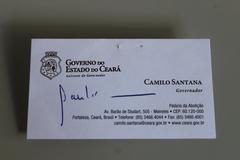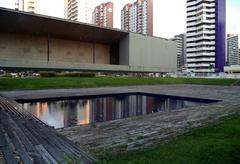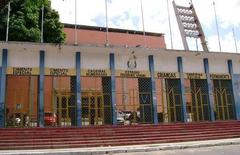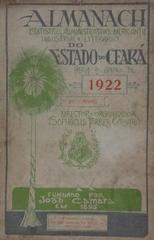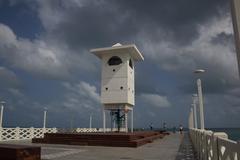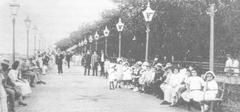
Palácio da Luz Visiting Hours, Tickets, and Fortaleza Historical Sites Guide
Date: 04/07/2025
Introduction
Palácio da Luz stands as a cornerstone of Fortaleza’s historical and cultural landscape. Constructed in the late 18th century, this neoclassical palace was initially the residence of captain-major Antônio de Castro Viana and later served as the seat of Ceará’s government. Today, it is the headquarters of the Academia Cearense de Letras, Brazil’s oldest literary academy, and a vibrant center for literature, arts, and public engagement. Centrally located on Rua do Rosário, Palácio da Luz is surrounded by other iconic sites such as Martyrs Square and Fortaleza Cathedral, making it an essential stop for anyone seeking to understand the city’s heritage. With free admission, extensive collections, and engaging events, it offers an enriching experience for history buffs, architecture enthusiasts, and cultural travelers alike. For current programming and visitor information, refer to the Academia Cearense de Letras website and Fortaleza’s cultural attractions guide.
Table of Contents
- Historical Overview
- Visiting Palácio da Luz: Essential Information
- Architectural Features and Styles
- Cultural Significance
- Visitor Information: Tickets, Hours, and Tours
- Visitor Experience Tips
- Arrival and Accessibility
- On-Site Experience
- Practical Information for Visitors
- Cultural Etiquette and Local Insights
- Nearby Attractions and Suggested Itineraries
- Tips for a Memorable Visit
- Frequently Asked Questions (FAQ)
- Visuals and Media Suggestions
- Useful Links
- Summary and Call to Action
Historical Overview
Origins and Early Construction
Construction of Palácio da Luz began around 1781, reflecting late Portuguese colonial architectural traditions. Initially built for captain-major Antônio de Castro Viana, it is one of Fortaleza’s oldest public buildings, created with the labor of indigenous people and using local materials (mapacultural.secult.ce.gov.br). The palace’s colonial features—thick masonry walls and modest windows—were designed for security and climate adaptation (e-a-a.com).
Transition to Government Headquarters
In 1814, the palace was acquired by the Imperial Government and became the seat of Ceará’s government, a role it held until 1960 (pt.wikipedia.org). The building has witnessed pivotal moments in Brazilian and Ceará’s history.
Architectural Evolution and Preservation
Although a partial demolition in 1960 resulted in the loss of some original details, Palácio da Luz retains its essential neoclassical character. It has been the subject of several restoration projects and is protected by state heritage directives (wikipedia.org, e-a-a.com).
Literary and Cultural Hub
Since 1966, the building has housed the Academia Cearense de Letras (mapacultural.secult.ce.gov.br), making it a crucial venue for literary events, exhibitions, and educational programs. Its library, with over 15,000 volumes, is a resource for researchers and the public.
Urban Significance
Located on Rua do Rosário, Palácio da Luz anchors the historical center of Fortaleza. The site is a tangible link to the city’s transformation from colonial settlement to modern metropolis (wanderlog.com).
Visiting Palácio da Luz: Essential Information
- Opening Hours: Tuesday to Friday, 9:00 AM – 5:00 PM; Saturday, 9:00 AM – 1:00 PM; closed Sundays and Mondays.
- Admission: Free.
- Guided Tours: Available on request (primarily in Portuguese; English tours can be arranged in advance).
- Accessibility: Ramps and accessible restrooms are available, though some historic areas may be less accessible.
- Photography: Permitted (no flash or tripods in most areas).
Architectural Features and Styles
Neoclassical Design
Palácio da Luz is a striking example of neoclassical architecture, featuring symmetrical proportions, grand columns, a triangular pediment, and whitewashed walls. The building’s rectangular layout is organized around a central courtyard, allowing natural light and ventilation—ideal for Fortaleza’s climate (Ceará Government).
Interior Elements
High ceilings, ornate cornices, and period furnishings evoke the ambiance of 19th-century Fortaleza. The central hardwood staircase and arrangement of rooms around the courtyard are characteristic of colonial Brazilian architecture.
Restoration
Significant restoration efforts have preserved the palace’s original features while equipping it for modern use as a cultural institution, including improved accessibility (Academia Cearense de Letras).
Cultural Significance
Literary and Artistic Center
The palace is home to the Academia Cearense de Letras, which promotes literature and cultural heritage through events, lectures, and exhibitions. Its extensive library is open to the public (Academia Cearense de Letras).
Regional Symbolism
Palácio da Luz epitomizes Ceará’s identity and resilience, having witnessed abolitionist, political, and artistic milestones. Its location amidst other landmarks strengthens its role as a cultural anchor (Brazil Explained).
Artistic Heritage
The palace contains portraits, artwork, and historical artifacts celebrating Ceará’s intellectual legacy. Rotating exhibitions and cultural programs foster community engagement.
Visitor Information: Tickets, Hours, and Tours
- Hours: Tuesday–Friday 9:00 AM–5:00 PM, Saturday 9:00 AM–1:00 PM, closed Sundays and Mondays.
- Tickets: Free admission.
- Guided Tours: Available with advance booking.
- Accessibility: Ramps and accessible restrooms (historic architecture may limit upper-floor access).
Visitor Experience Tips
- Best Time to Visit: Weekday mornings for fewer crowds.
- Photography: Allowed in most areas; follow signage for restrictions.
- Nearby Attractions: Walk to Martyrs Square, Fortaleza Cathedral, Mercado Central, and Dragão do Mar Center of Art and Culture (Brazil Explained).
- Safety: Remain vigilant in downtown areas, especially after dark.
- Weather: Fortaleza is warm and humid—wear light clothing, use sunscreen, and hydrate.
Arrival and Accessibility
- Address: Rua do Rosário, 01, Fortaleza.
- Getting There: Accessible by bus (Centro lines), taxi, or ride-share. Walking distance from Ferreira Square (Evendo).
- Accessibility: Ramps provided; some cobblestone areas outside.
On-Site Experience
- Ambience: Grand neoclassical façade, period interiors, and tranquil gardens.
- Exhibits: Focus on Fortaleza’s history, Ceará’s culture, and literary achievements.
- Gardens: Shaded, landscaped spaces for relaxation and photography.
Practical Information for Visitors
- Facilities: Restrooms, seating, small gift shop, occasional free Wi-Fi.
- Security: On-site personnel during opening hours.
- Dress Code: Casual, weather-appropriate attire; respectful dress for events.
- Language: Portuguese is spoken; translation apps recommended.
Cultural Etiquette and Local Insights
- Customs: Greet staff warmly; ask before photographing people or restricted exhibits.
- Local Cuisine: Try nearby regional dishes like carne de sol or peixada cearense (Adventure Backpack).
Nearby Attractions and Suggested Itineraries
- Ferreira Square: Historic clock, local vendors.
- José de Alencar Theater: Renowned architecture and performances.
- Mercado Central: Crafts and culinary specialties.
- Dragão do Mar Center of Art and Culture: Museums, galleries, and nightlife (Budget Your Trip).
Suggested itinerary: Morning at Palácio da Luz, lunch at a local restaurant, afternoon exploring Mercado Central or Dragão do Mar.
Tips for a Memorable Visit
- Visit early for quiet and optimal photos.
- Bring sun protection and rain gear (wet season: Feb–May).
- Check for cultural events and exhibitions in advance.
- Sample regional foods at local eateries.
Frequently Asked Questions (FAQ)
Q: What are Palácio da Luz’s opening hours?
A: Tuesday–Friday 9:00 AM–5:00 PM, Saturday 9:00 AM–1:00 PM, closed Sundays and Mondays.
Q: Is there an entrance fee?
A: Admission is free.
Q: Are guided tours available?
A: Yes, primarily in Portuguese. English tours require advance booking.
Q: Is the palace accessible to visitors with disabilities?
A: Ramps and accessible restrooms are provided, but some areas may be less accessible.
Q: Can I take photographs?
A: Non-flash photography is allowed in most areas; follow restrictions as posted.
Visuals and Media Suggestions
- Include high-resolution images of the palace’s façade, gardens, and interior with descriptive alt tags.
- Embed a virtual tour or video walkthrough for remote visitors.
- Use internal links to related articles on Fortaleza’s historical and cultural sites.
Useful Links
- Academia Cearense de Letras
- Palácio da Luz on Mapacultural
- Official Fortaleza Tourism Portal
- Brazil Explained – Things to Do in Fortaleza
- Evendo – Palácio da Luz
- Adventure Backpack – Fortaleza Highlights
- Budget Your Trip – Fortaleza
Summary and Call to Action
Palácio da Luz embodies Fortaleza’s historical evolution and cultural vibrancy. Its imposing neoclassical architecture, literary heritage, and expansive gardens offer a memorable experience for every visitor. With free admission, accessibility improvements, and a central location near major attractions, Palácio da Luz welcomes travelers of all backgrounds. For the latest updates on hours, events, and tours, visit the official Academia Cearense de Letras portal, and enhance your journey with the Audiala app for curated travel guides and audio tours. Explore, connect, and share in the legacy of one of Brazil’s most significant historical sites.

